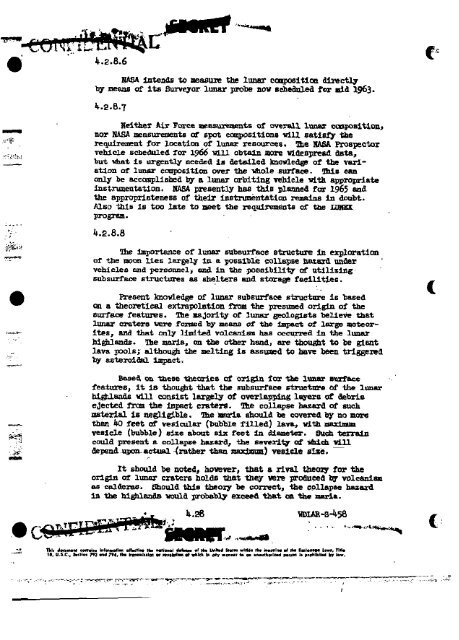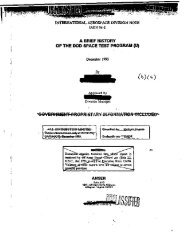LUNAR EXPEDITION PLAN
LUNAR EXPEDITION PLAN
LUNAR EXPEDITION PLAN
You also want an ePaper? Increase the reach of your titles
YUMPU automatically turns print PDFs into web optimized ePapers that Google loves.
4.2.6.6<br />
NASA intends to measure the lunar composition directly<br />
by means of Its Surveyor lunar probe now scheduled for Bid I963.<br />
4.2.8.7<br />
Neither Air Force measurements of overall lunar composition;<br />
nor NASA measurements of spot compositions will satisfy the<br />
requirement for location of lunar resources. Una NASA Prospector<br />
vehicle scheduled for 1966 will obtain store widespread data,<br />
but vti&t Is urgently needed is detailed knowledge of the variation<br />
of lunar composition over the whole surface. Ohis can<br />
only be accompli shed by & lunar orbiting vehicle with appropriate<br />
instrumentation. NASA presently has this planned for 1965 and<br />
the appropriateness of their Instrumentation remains in doubt.<br />
Also this is too late to meet the requirements of the LUHEX<br />
program.<br />
4.2.8.8<br />
2he Importance of lunar subsurface structure in exploration<br />
of the moon lies largely In a possible collapse hazard under<br />
vehicles and personnel, and in the possibility of utilizing -<br />
subsurface structures as shelters and storage facilities.<br />
Present knowledge of lunar subsurface structure 1B based<br />
on a theoretical extrapolation from the presumed origin of the<br />
surface features. The majority of lunar geologists believe that<br />
lunar craters vere formed by means of the impact of large meteorites,<br />
and that only limited volcanlsm has occurred in the lunar<br />
highlands. 3he maria, en the other hand, are thought to be giant<br />
lava pools; although the melting is assumed to have been triggered<br />
by asteroldal impact.<br />
Based on these theories of origin for the lunar surface<br />
features, it is thought that the subsurface structure of the lunar<br />
highlands will consist largely Of overlapping layers of debris<br />
ejected from the impact craters. One collapse hazard of such<br />
material is negligible. 3he maria should be covered by no more<br />
than kO feet of vesicular (bubble filled) lava, -with "«^"i""<br />
vesicle (bubble) size about six feet in diameter. Such terrain<br />
could present a collapse hazard, the severity of which will<br />
depend- upon-actual ^rather than maximum) vesicle size.<br />
It should be noted, however, that a rival theory for the<br />
origin of lunar craters holds that they were produced by volcanlsm<br />
as calderas. Should this theory be correct, the collapse hazard<br />
in the highlands would probably exceed that on the maria.<br />
TOLAS-S-458<br />
Thli da»«M nMsiiu M*n.at>Mi oFhcHna Ik. notional frfam *F M •onn#j la on nMuthoitiad patten 1> aiafcibBaa: a* law.<br />
C




